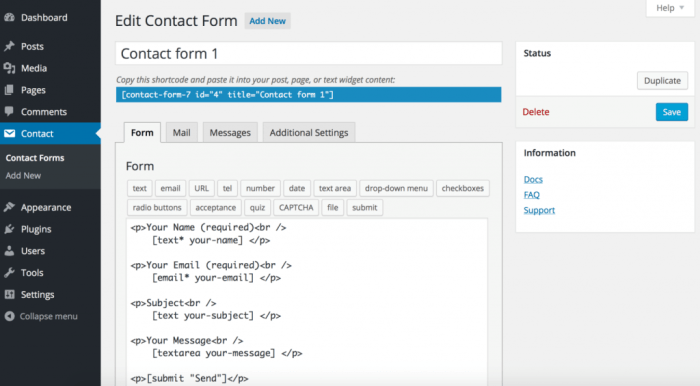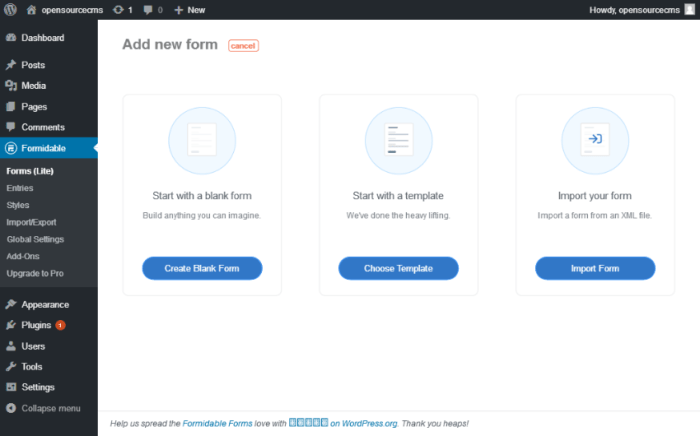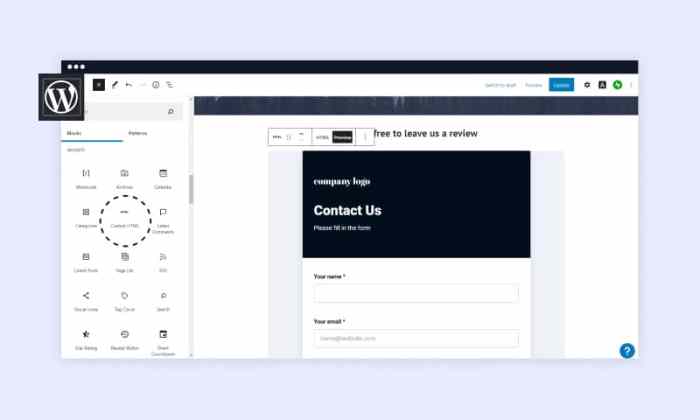Building a functional and aesthetically pleasing contact form on your WordPress website is crucial for effective communication with your audience. Fortunately, several free methods exist, eliminating the need for expensive plugins or coding expertise. This comprehensive guide will walk you through various approaches, ensuring you can choose the best option for your needs and technical skills.

Source: templatetoaster.com
Understanding the Importance of a Contact Form
A well-designed contact form streamlines communication, allowing visitors to easily reach you with inquiries, feedback, or support requests. This enhances user experience, fosters engagement, and ultimately contributes to your website’s success. Compared to relying solely on email addresses displayed publicly, a contact form offers several key advantages:
- Reduced Spam: Contact forms often incorporate spam protection measures, significantly reducing unwanted emails.
- Organized Inquiries: All incoming messages are collected in one place, making them easier to manage and track.
- Improved User Experience: Forms are user-friendly and intuitive, providing a simple way for visitors to connect.
- Enhanced Professionalism: A well-designed form projects a professional image for your website.
- Data Collection: You can collect valuable information from users beyond just their message, such as name and email address, to better understand your audience.
Method 1: Using WordPress’s Built-in Contact Form Functionality (Limited)
While WordPress doesn’t offer a fully-fledged contact form builder out-of-the-box, you can create a basic contact form using the default comment system. This is a very simple method, suitable only for the most basic needs. It’s not ideal for complex forms or high volumes of inquiries.

Source: tutsplus.com
Steps:
- Create a new page: Go to Pages > Add New.
- Add a comment section: Ensure the comment section is enabled on this page. You can usually find this option in the page settings or screen options.
- Customize the comment form (limited): You can slightly adjust the comment form fields by using a plugin like “Comment Form Customizer,” although this method remains fairly basic.
- Monitor comments: Check your comments section regularly for new messages. This method lacks the sophistication of dedicated contact form plugins.
Limitations: This approach lacks advanced features like spam protection, customizable fields, and automated email notifications. It’s best suited for very simple websites with minimal contact volume.
Method 2: Utilizing Free Contact Form Plugins
Several free WordPress plugins provide robust contact form functionality. These plugins offer a wide range of features, including spam protection, customizable fields, and email notifications. Here are a few popular options:
Contact Form 7
Contact Form 7 is a highly popular and versatile free plugin. It allows for creating multiple contact forms with various fields, including text fields, email fields, checkboxes, radio buttons, and more. It also offers basic spam protection and customization options.
- Pros: Highly customizable, widely used, excellent documentation.
- Cons: Can be slightly more complex to use than some other plugins for beginners.
WPForms Lite
WPForms Lite is a user-friendly option, ideal for beginners. While the free version has limitations compared to its paid counterpart, it provides a good starting point for creating simple contact forms.
- Pros: Intuitive drag-and-drop interface, easy to use.
- Cons: Fewer features compared to the paid version and other plugins.
Other Free Options:
Other free plugins are available, but their features and user-friendliness may vary. Always check user reviews and plugin ratings before installing any plugin.
Step-by-Step Guide: Creating a Contact Form with Contact Form 7
Let’s walk through creating a basic contact form using Contact Form 7. This is a popular choice due to its balance of power and ease of use.
1. Installation and Activation
Install and activate the Contact Form 7 plugin from your WordPress dashboard (Plugins > Add New).
2. Creating a New Contact Form
Navigate to Contact > Add New. You’ll see a text area where you’ll define your form’s fields using shortcodes.
3. Defining Form Fields
Use the following shortcodes to add fields:
- [text* your-name]: A required text field for the user’s name.
- [email* your-email]: A required email field for the user’s email address.
- [text your-subject]: An optional subject field.
- [textarea your-message]: A text area for the user’s message.
- [submit “Send”] : The submit button.
Remember to replace the bracketed placeholders with your desired field names.
4. Setting Up Email Notifications
Navigate to the “Mail” tab in the Contact Form 7 editor. Here, you can configure the email settings. You’ll need to specify the recipient email address, subject line, and message body.
5. Adding the Form to Your Page or Post

Source: embedsocial.com
Copy the shortcode generated by Contact Form 7 (usually something like `[contact-form-7 id=”123″ title=”Contact form 1″]`) and paste it into the page or post where you want the form to appear.
6. Testing the Form
Save your page or post and preview it to ensure the form works correctly. Submit a test message to verify that you receive the email notification.
Advanced Contact Form Features and Considerations
While the basic forms are sufficient for many, consider these advanced features as your needs grow:
- Spam Protection: Implement robust spam filtering, such as reCAPTCHA (requires integration with a plugin like Really Simple CAPTCHA) to minimize spam submissions.
- Custom Fields: Add specific fields relevant to your business, such as phone numbers, addresses, or order numbers.
- Form Styling: Customize the form’s appearance using CSS to match your website’s design. Many plugins offer customization options, or you can manually add CSS to your theme’s stylesheet.
- Integration with CRM or Email Marketing Services: Connect your contact form to your CRM or email marketing platform (like Mailchimp or HubSpot) to automate lead capture and follow-up.
- Analytics: Track form submissions to monitor user engagement and identify areas for improvement.
Frequently Asked Questions (FAQ)
- Q: Is it possible to create a contact form without any plugins? A: Yes, you can use the basic WordPress comment system, but it’s very limited in functionality and lacks advanced features.
- Q: Which is the best free contact form plugin? A: The “best” plugin depends on your needs and technical skills. Contact Form 7 is powerful but requires some technical understanding, while WPForms Lite is more user-friendly but has fewer features.
- Q: How do I prevent spam submissions? A: Use reCAPTCHA or other spam protection methods offered by your chosen plugin.
- Q: Can I customize the appearance of my contact form? A: Yes, you can customize the form’s appearance using CSS or through the plugin’s customization options.
- Q: What happens to the data submitted through the contact form? A: The data is typically sent to the email address you specify in the plugin’s settings. Consider using a plugin that integrates with a CRM or email marketing service for better data management.
Resources
- Contact Form 7 Plugin
- WPForms Plugin
- Really Simple CAPTCHA Plugin
- WordPress CSS and Javascript inclusion
Call to Action
Start creating your free WordPress contact form today! Choose the method that best suits your technical skills and website needs. Enhance your website’s user experience and communication capabilities by providing a simple and effective way for visitors to connect with you.
Query Resolution
What if I need more advanced features than a free plugin offers?
Many free plugins offer extensions or premium versions with advanced features like spam protection or integrations with other services. Consider upgrading if your needs grow.
Can I customize the look of my contact form?
Yes, most free contact form plugins allow for some level of customization, enabling you to match the form’s style to your website’s design. This often involves simple CSS adjustments or using themes offered within the plugin.
How do I handle submitted contact form data?
Many plugins automatically send submissions to your email address. Some offer integration with CRM systems for more advanced management of leads and inquiries.
What happens if my free plugin is no longer supported?
Always look for well-maintained plugins with active communities and regular updates. If a plugin is abandoned, consider switching to a supported alternative.